2016 MERCEDES-BENZ S-COUPE steering
[x] Cancel search: steeringPage 23 of 410
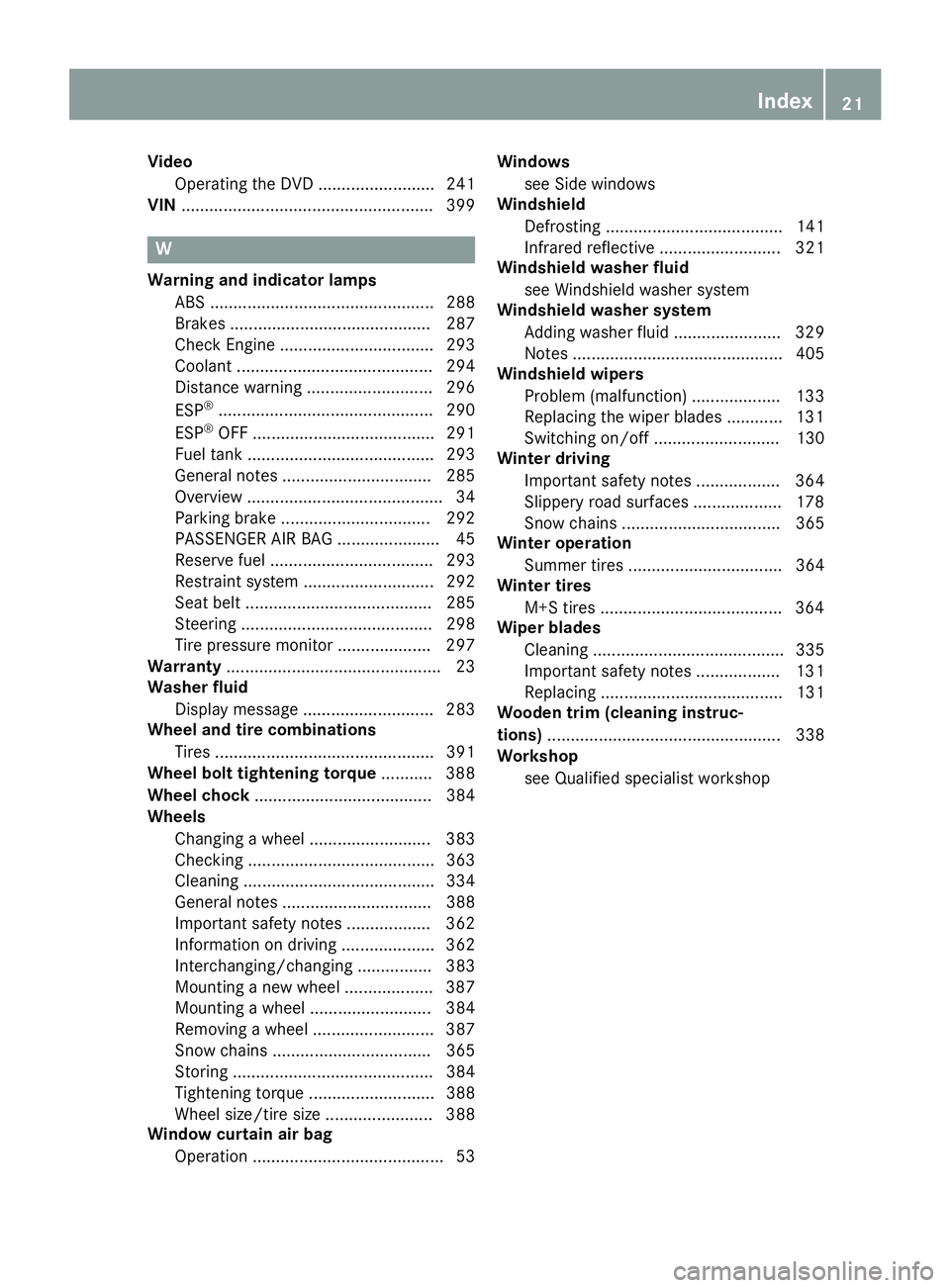
VideoOperating the DVD ......................... 241
VIN ...................................................... 399
W
Warning and indicator lamps
ABS ................................................ 288
Brakes ........................................... 287
Check Engine ................................. 293
Coolant .......................................... 294
Distance warning ........................... 296
ESP
®.............................................. 290
ESP®OFF ....................................... 291
Fuel tank ........................................ 293
General notes ................................ 285
Overview .......................................... 34
Parking brake ................................ 292
PASSENGER AIR BAG ...................... 45
Reserve fuel ................................... 293
Restraint system ............................ 292
Seat belt ........................................ 285
Steering ......................................... 298
Tire pressure monitor .................... 297
Warranty .............................................. 23
Washer fluid
Display message ............................ 283
Wheel and tire combinations
Tires ............................................... 391
Wheel bolt tightening torque ........... 388
Wheel chock ...................................... 384
Wheels
Changing a wheel .......................... 383
Checking ........................................ 363
Cleaning ......................................... 334
General notes ................................ 388
Important safety notes .................. 362
Information on driving .................... 362
Interchanging/changing ................ 383
Mounting a new wheel ................... 387
Mounting a wheel .......................... 384
Removing a wheel .......................... 387
Snow chains .................................. 365
Storing ........................................... 384
Tightening torque ........................... 388
Wheel size/tire size ....................... 388
Window curtain air bag
Operation ......................................... 53 Windows
see Side windows
Windshield
Defrosting ...................................... 141
Infrared reflective .......................... 321
Windshield washer fluid
see Windshield washer system
Windshield washer system
Adding washer fluid ....................... 329
Notes ............................................. 405
Windshield wipers
Problem (malfunction) ................... 133
Replacing the wiper blades ............ 131
Switching on/off ........................... 130
Winter driving
Important safety notes .................. 364
Slippery road surfaces ................... 178
Snow chains .................................. 365
Winter operation
Summer tires ................................. 364
Winter tires
M+S tires ....................................... 364
Wi
per blades
Cleaning ......................................... 335
Important safety notes .................. 131
Replacing ....................................... 131
Wooden trim (cleaning instruc-
tions) .................................................. 338
Workshop
see Qualified specialist workshop
Index21
Page 30 of 410
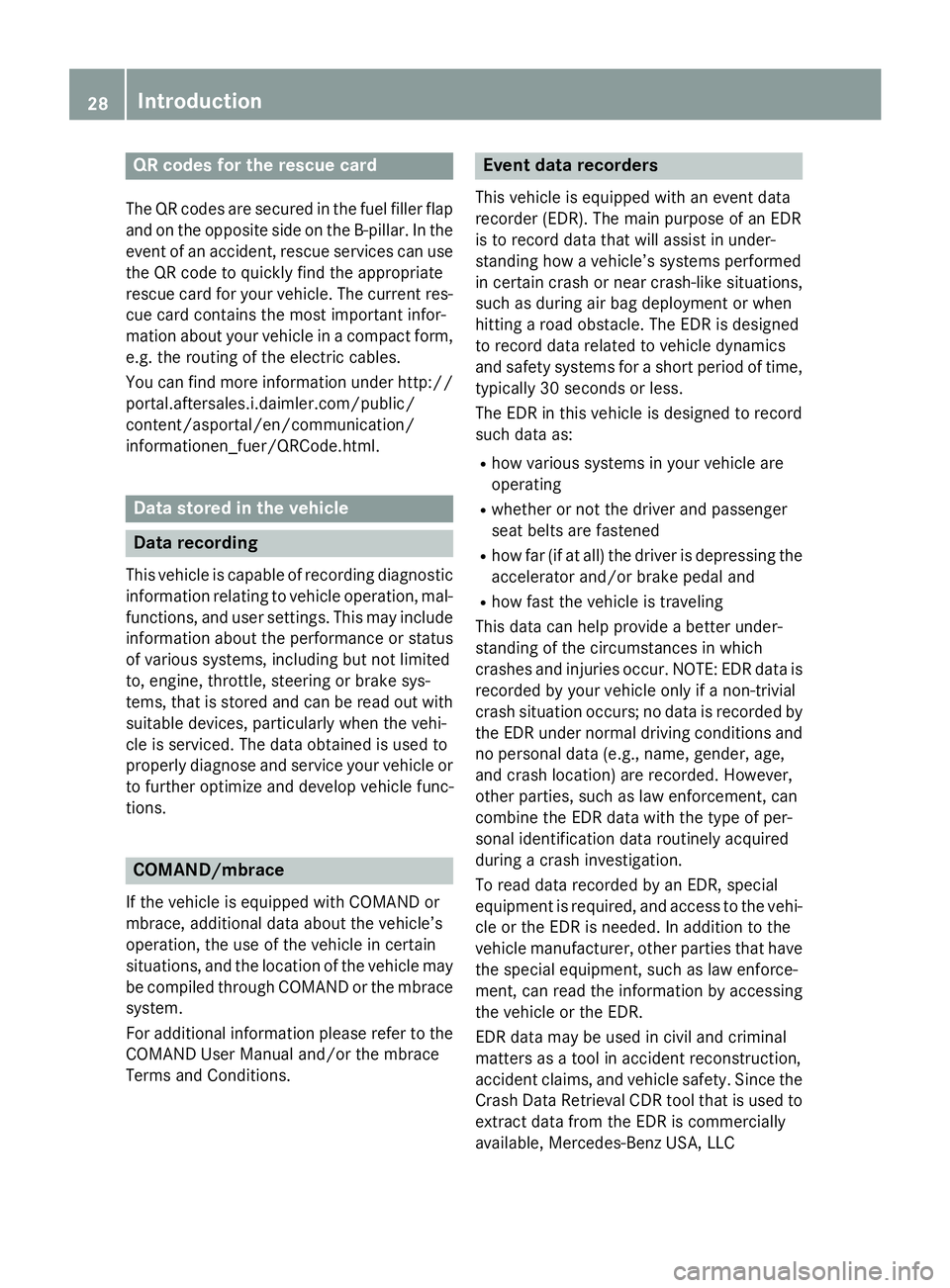
QR codes for the rescue card
The QR codes are secured in the fuel filler flap
and on the opposite side on the B-pillar. In the event of an accident, rescue services can use
the QR code to quickly find the appropriate
rescue card for your vehicle. The current res-
cue card contains the most important infor-
mation about your vehicle in a compact form,
e.g. the routing of the electric cables.
You can find more information under http://
portal.aftersales.i.daimler.com/public/
content/asportal/en/communication/
informationen_fuer/QRCode.html.
Data stored in the vehicle
Data recording
This vehicle is capable of recording diagnostic
information relating to vehicle operation, mal-
functions, and user settings. This may include information about the performance or status
of various systems, including but not limited
to, engine, throttle, steering or brake sys-
tems, that is stored and can be read out with
suitable devices, particularly when the vehi-
cle is serviced. The data obtained is used to
properly diagnose and service your vehicle or
to further optimize and develop vehicle func-
tions.
COMAND/mbrace
If the vehicle is equipped with COMAND or
mbrace, additional data about the vehicle’s
operation, the use of the vehicle in certain
situations, and the location of the vehicle may
be compiled through COMAND or the mbrace
system.
For additional information please refer to the
COMAND User Manual and/or the mbrace
Terms and Conditions.
Event data recorders
This vehicle is equipped with an event data
recorder (EDR). The main purpose of an EDR
is to record data that will assist in under-
standing how a vehicle’s systems performed
in certain crash or near crash-like situations,
such as during air bag deployment or when
hitting a road obstacle. The EDR is designed
to record data related to vehicle dynamics
and safety systems for a short period of time,
typically 30 seconds or less.
The EDR in this vehicle is designed to record
such data as:
Rhow various systems in your vehicle are
operating
Rwhether or not the driver and passenger
seat belts are fastened
Rhow far (if at all) the driver is depressing the
accelerator and/or brake pedal and
Rhow fast the vehicle is traveling
This data can help provide a better under-
standing of the circumstances in which
crashes and injuries occur. NOTE: EDR data is
recorded by your vehicle only if a non-trivial
crash situation occurs; no data is recorded by the EDR under normal driving conditions and
no personal data (e.g., name, gender, age,
and crash location) are recorded. However,
other parties, such as law enforcement, can
combine the EDR data with the type of per-
sonal identification data routinely acquired
during a crash investigation.
To read data recorded by an EDR, special
equipment is required, and access to the vehi-
cle or the EDR is needed. In addition to the
vehicle manufacturer, other parties that have
the special equipment, such as law enforce-
ment, can read the information by accessing
the vehicle or the EDR.
EDR data may be used in civil and criminal
matters as a tool in accident reconstruction,
accident claims, and vehicle safety. Since the
Crash Data Retrieval CDR tool that is used to
extract data from the EDR is commercially
available, Mercedes-Benz USA, LLC
28Introduction
Page 33 of 410
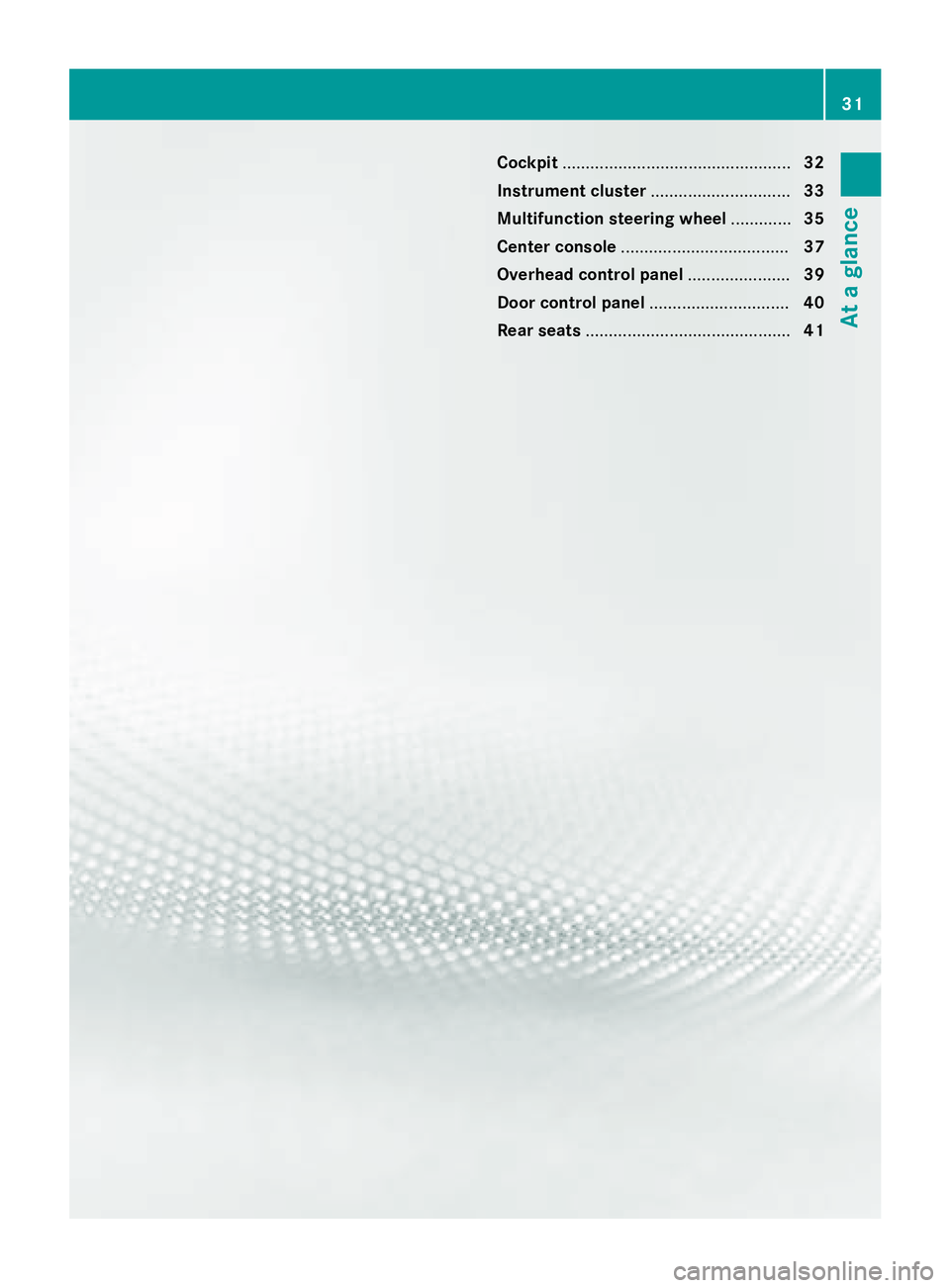
Cockpit................................................. 32
Instrument cluster ..............................33
Multifunction steering wheel .............35
Center console .................................... 37
Overhead control panel ......................39
Door control panel .............................. 40
Rear seats ............................................ 41
31
At a glance
Page 34 of 410

Cockpit
FunctionPage
:Steering wheel paddle
shifters
163
;Combination switch126
=Horn
?Instrument cluster33
ADIRECT SELECT lever159
BOverhead control panel39
CControl panel for:
ÜLowering the rear
seat head restraints
110
u Extending/retracting
the rear roller sunblind
306
Moving the seat-belt
extender forwards
48
PASSENGER AIR BAG indi-
cator lamp
45
Setting the brightness of
the instrument cluster light-
ing and the COMAND dis-
play
DClimate control systems136
FunctionPage
EIgnition lock151
Start/Stop button151
FAdjusts the steering wheel114
Steering wheel heating115
GCruise control lever180
HElectric parking brake172
IDiagnostics connection26
JOpens the hood324
KLight switch124
LControl panel for:
Activating Steering Assist
and Stop&Go Pilot
190
Switching on Active Lane
Keeping Assist
225
Deactivating PARKTRONIC199
Switching on the 360° cam-
era
211
Activating Night View
Assist
219
Switching on the head-up
display
233
32Cockpit
At a glance
Page 36 of 410

Warning and indicator lamps
FunctionPage
:!ABS288
;åESP®OFF290
÷ESP®290
=#Turn signal, left126
?LLow-beam head-
lamps
125
AK High-beam head-
lamps
126
BT Parking lamps,
license plate lamps and
instrument cluster lighting
125
C! Turn signal, right126
D·Distance warning sig-
nal
296
FunctionPage
E! Electric parking brake
(yellow)
292
FElectric parking brake (red)292
F USA only
!Canada only
G;Check Engine293
HÐ Power steering298
IBrakes (red)287
$USA only
JCanada only
JüSeat belt285
K6Restraint system292
LhTire pressure monitor297
34Instrument cluster
At a glance
Page 37 of 410
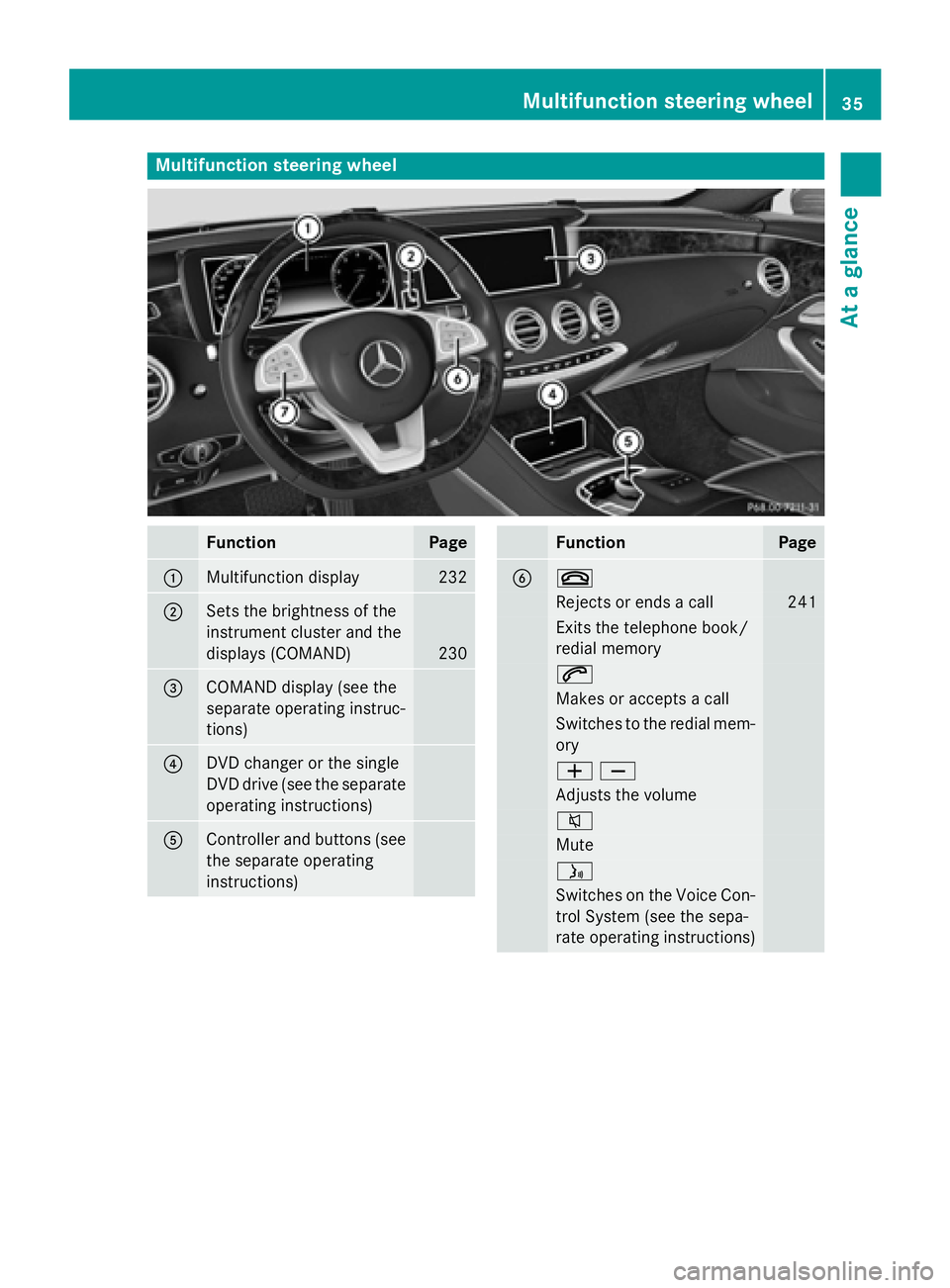
Multifunction steering wheel
FunctionPage
:Multifunction display232
;Sets the brightness of the
instrument cluster and the
displays (COMAND)
230
=COMAND display (see the
separate operating instruc-
tions)
?DVD changer or the single
DVD drive (see the separate
operating instructions)
AController and buttons (see
the separate operating
instructions)
FunctionPage
B~
Rejects or ends a call241
Exits the telephone book/
redial memory
6
Makes or accepts a call
Switches to the redial mem-
ory
WX
Adjusts the volume
8
Mute
ó
Switches on the Voice Con-
trol System (see the sepa-
rate operating instructions)
Multifunction steering wheel35
At a glance
Page 38 of 410
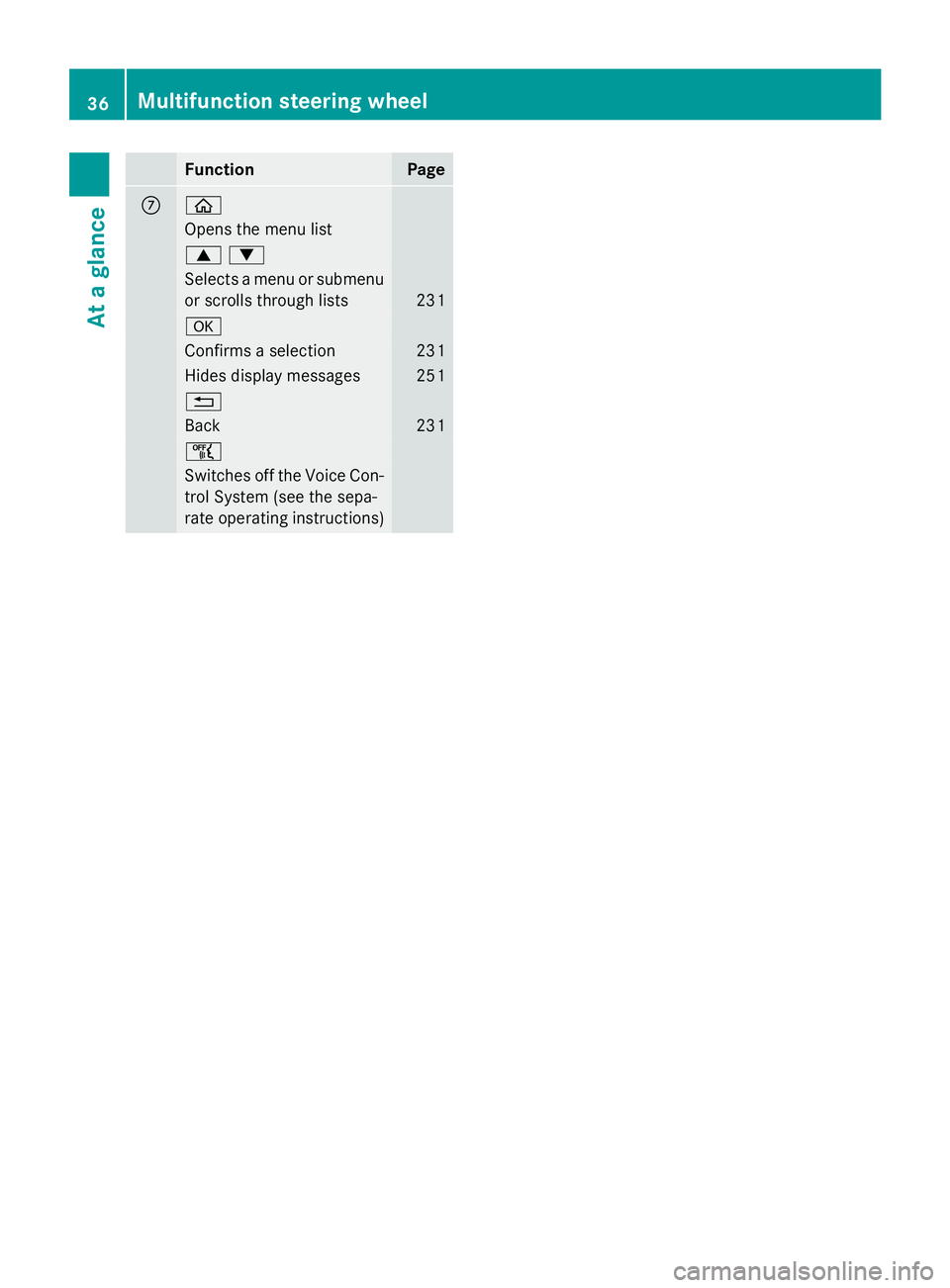
FunctionPage
Cò
Opens the menu list
9:
Selects a menu or submenu
or scrolls through lists
231
a
Confirms a selection231
Hides display messages251
%
Back231
ñ
Switches off the Voice Con-
trol System (see the sepa-
rate operating instructions)
36Multifunction steering wheel
At a glance
Page 46 of 410
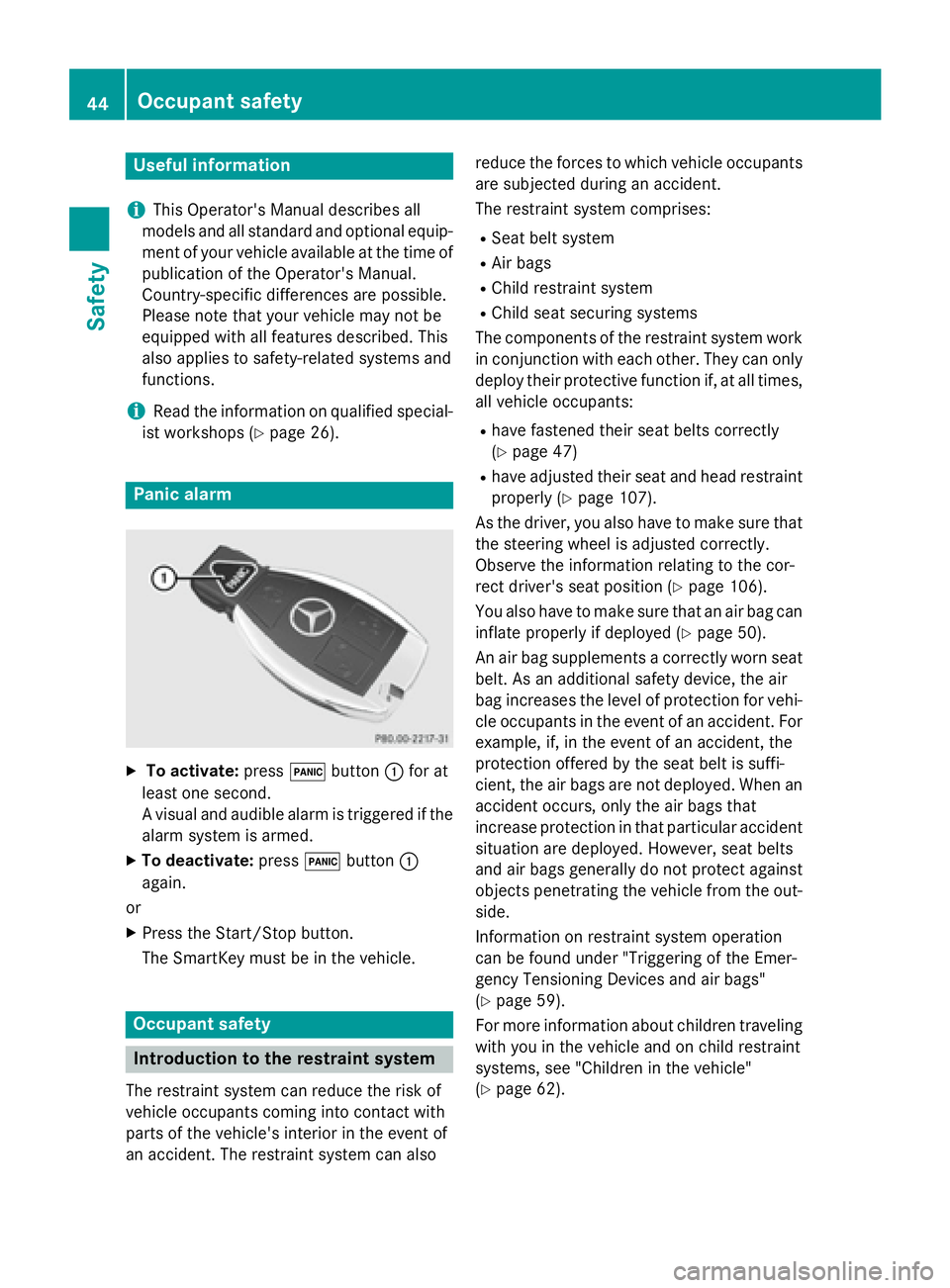
Useful information
i
This Operator's Manual describes all
models and all standard and optional equip-
ment of your vehicle available at the time of
publication of the Operator's Manual.
Country-specific differences are possible.
Please note that your vehicle may not be
equipped with all features described. This
also applies to safety-related systems and
functions.
iRead the information on qualified special-
ist workshops (
Ypage 26).
Panic alarm
XTo activate: press!button :for at
least one second.
A visual and audible alarm is triggered if the
alarm system is armed.
XTo deactivate: press!button :
again.
or
XPress the Start/Stop button.
The SmartKey must be in the vehicle.
Occupant safety
Introduction to the restraint system
The restraint system can reduce the risk of
vehicle occupants coming into contact with
parts of the vehicle's interior in the event of
an accident. The restraint system can also reduce the forces to which vehicle occupants
are subjected during an accident.
The restraint system comprises:
RSeat belt system
RAir bags
RChild restraint system
RChild seat securing systems
The components of the restraint system work in conjunction with each other. They can only
deploy their protective function if, at all times,
all vehicle occupants:
Rhave fastened their seat belts correctly
(
Ypage 47)
Rhave adjusted their seat and head restraint
properly (
Ypage 107).
As the driver, you also have to make sure that
the steering wheel is adjusted correctly.
Observe the information relating to the cor-
rect driver's seat position (
Ypage 106).
You also have to make sure that an air bag can inflate properly if deployed (
Ypage 50).
An air bag supplements a correctly worn seat
belt. As an additional safety device, the air
bag increases the level of protection for vehi-
cle occupants in the event of an accident. For
example, if, in the event of an accident, the
protection offered by the seat belt is suffi-
cient, the air bags are not deployed. When an
accident occurs, only the air bags that
increase protection in that particular accident
situation are deployed. However, seat belts
and air bags generally do not protect against objects penetrating the vehicle from the out-
side.
Information on restraint system operation
can be found under "Triggering of the Emer-
gency Tensioning Devices and air bags"
(
Ypage 59).
For more information about children traveling
with you in the vehicle and on child restraint
systems, see "Children in the vehicle"
(
Ypage 62).
44Occupant safety
Safety